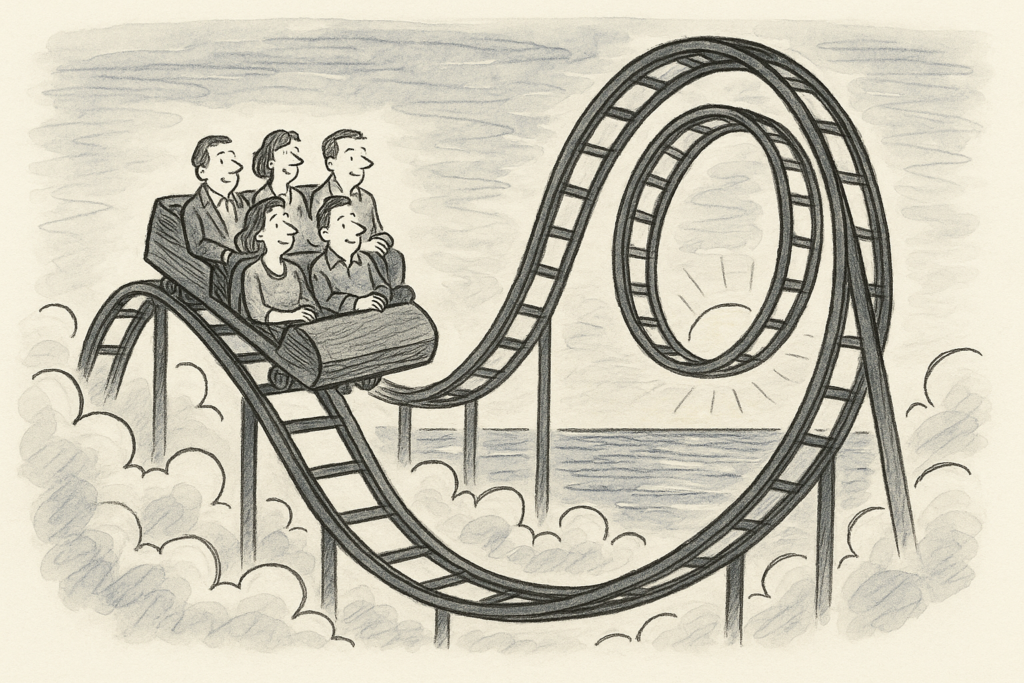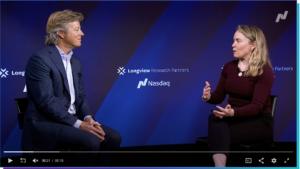Details Are Part of Our Difference
Embracing the Evidence at Anheuser-Busch – Mid 1980s
529 Best Practices
David Booth on How to Choose an Advisor
The One Minute Audio Clip You Need to Hear
Category: Featured
A Timely Reminder to Keep Going
 Market volatility is back in the headlines, and if you’re feeling uneasy, you’re not alone. Over the past month, markets have given us another sharp reminder of what it means to be an investor. On April 2nd and 3rd, the S&P 500 fell a combined 10.7%—a drop that understandably triggered anxiety for some. And just when the idea of sitting on the sidelines might have felt tempting, the market turned on a dime. On April 9th, the S&P 500 gained 10.5% in a single day, quickly recapturing much of the prior decline.
Market volatility is back in the headlines, and if you’re feeling uneasy, you’re not alone. Over the past month, markets have given us another sharp reminder of what it means to be an investor. On April 2nd and 3rd, the S&P 500 fell a combined 10.7%—a drop that understandably triggered anxiety for some. And just when the idea of sitting on the sidelines might have felt tempting, the market turned on a dime. On April 9th, the S&P 500 gained 10.5% in a single day, quickly recapturing much of the prior decline.
That’s the market. It moves. Sometimes violently. In hourly bursts. Often unpredictably. And always in response to new information.
One of the best examples of this came on April 9th at 1:18 p.m. Eastern, when President Trump posted on Truth Social that he would lift tariffs on all countries other than China. Within ten minutes of that post, the S&P 500 had surged nearly 6%. Markets are incredibly efficient at digesting new information, whether it’s about trade policy, inflation, interest rates, or elections. The current price of a security reflects the consensus expectations of millions of participants, each with skin in the game.
So what should you do in the face of this kind of uncertainty?
Stick with your plan.
At Hill Investment Group, every client portfolio is built around a long-term strategy, not short-term noise. Your plan was designed with the understanding that markets will experience sharp moves, both up and down. We don’t pretend to know what tomorrow’s headlines will be or how the market will respond to them. What we do know—based on decades of data and mountains of research—is that markets are priced to deliver a positive expected return every single day. That’s why being in the market is so critical.
Missing just a handful of the best days has an outsized impact on long-term results. And as we just saw, those days often come immediately after the worst ones. Getting out and waiting “until the dust settles” may feel comforting, but it’s rarely profitable.
Global diversification is also part of the plan.
This year offers a good reminder of why. While the S&P 500 is down 9.7% year-to-date as of April 22nd, international developed and emerging markets are actually up 6.3%. No one can consistently predict which areas of the market will outperform in the short term. That’s why we build portfolios that don’t rely on a single country or asset class to deliver returns. Diversification ensures that when one area of the market struggles, others may pick up the slack. It’s not just about reducing risk—it’s about improving the odds of long-term success.
Instead of reacting to volatility, we encourage our clients to focus on what can be controlled—things that actually add value:
- Tax Loss Harvesting – When markets decline, we actively harvest losses to offset gains elsewhere in your portfolio. This reduces your tax bill while keeping you invested.
- Rebalancing – We monitor portfolios to ensure your exposure to risk remains aligned with your plan, buying when assets are down and trimming when they’ve run up.
- Staying the Course – Most importantly, we help you stay focused on the big picture. Financial goals aren’t achieved in a week or a month—they’re met over years and decades by maintaining discipline and a long-term perspective.
Trying to respond to every market move or every tweet is not an investment strategy. It’s gambling. It’s a recipe for regret.
So yes, volatility has returned. And no, we can’t predict what comes next. But we can control how we respond. And our response is grounded in evidence, backed by decades of research, and aligned with your goals.
We’re here to help you take the long view. That’s not just a tagline—it’s a philosophy that has helped our clients build and preserve wealth through all kinds of markets. And it’s one we continue to believe in today.
Stick with it.
Hill Investment Group is a registered investment adviser. Registration of an Investment Advisor does not imply any level of skill or training. This information is educational and does not intend to make an offer for the sale of any specific securities, investments, or strategies. Investments involve risk, and past performance is not indicative of future performance.
Navigating the Market Downturn: A Note to Our Clients
 If the recent market turbulence has you feeling unsettled, you’re not alone. Whether you’re retired, still saving, or somewhere in between, it’s natural to feel the urge to “do something.” But moments like these are precisely why your portfolio was built with care and foresight.
If the recent market turbulence has you feeling unsettled, you’re not alone. Whether you’re retired, still saving, or somewhere in between, it’s natural to feel the urge to “do something.” But moments like these are precisely why your portfolio was built with care and foresight.
Here’s how we’re thinking about this moment—and how you can, too:
For Retirees and Near-Retirees:
Your portfolio includes years’ worth of conservative fixed income—intentionally. That cushion is what allows you to ride through downturns without needing to change your lifestyle or your plan. Stability was built in for exactly this reason.
For Accumulators (Still Saving):
If you’re still in growth mode, volatility has a silver lining. Down markets give you the chance to buy great businesses at lower prices—essentially investing in your future at a discount. It may not feel good in the moment, but it’s a long-term gift.
Understanding Volatility:
Markets rise over time—that’s the first truth. The second? They often fall along the way. Since 1990, the market has averaged a 10.5% annual return. But within each of those years, the average drop was 14%. Roughly every five years, we’ve seen a drop twice that size. This week isn’t a surprise—it’s part of the journey.
Why This Drop Feels Different:
This downturn stings because it’s policy-driven—our leaders’ decisions caused global turbulence. That makes it feel personal, even avoidable. But it’s not evidence that the system is broken. In fact, it’s proof that capitalism endures.
The Market Is Resilient:
Time and again, companies adapt. They grow earnings, find new efficiencies, and create value through war, recessions, political turmoil, and global crises. Your portfolio isn’t built for perfection—it’s built for reality and for the long arc of progress.
Our Approach:
You’ll never hear us say, “It’s time to go to cash.” That’s not a strategy—it’s a reaction. Our philosophy is rooted in evidence, patience, and discipline. It’s why we stay the course and take the long view.
As always, we’re here if you want to talk.
March Journal Email Intro – Closing Bell Opening Day

When our last newsletter hit your inbox, it was a milestone day—the official launch of The Longview Advantage ETF. Now, just a month later, we’re off to a fantastic start. One of the highlights? Ringing the closing bell at Nasdaq. It was more than just a photo op (though we’ve included a great one above)—it was a symbol of what this fund represents: long-term thinking, disciplined investing, and alignment with partners who share our values.
What follows is a brief look at why we chose Nasdaq as our listing partner and how that decision reflects the principles at the core of Hill Investment Group and Longview Research Partners.
Why We Chose Nasdaq: A Commitment to Aligned Values
When we decided to launch The Longview Advantage ETF (EBI), we knew that every choice mattered—down to where we listed the fund. Selecting Nasdaq wasn’t just about visibility or reputation; it was about alignment.
At Hill Investment Group and Longview Research Partners (the parent name of the ETF), our core philosophy is built on evidence, transparency, and a forward-thinking approach. These values aren’t just words—they guide everything we do, from the way we serve clients to the investment principles behind our ETF. When we looked at Nasdaq, we saw an organization that operates with the same commitment to innovation, efficiency, and integrity.
Innovation Meets Evidence-Based Investing
Nasdaq has long been a home for companies that challenge the status quo—firms that look beyond convention and embrace a data-driven, systematic approach to growth. That same mindset fuels The Longview Advantage ETF. Our strategy is built on decades of research and combines the most compelling ideas in the evidence-based community into one fund. It’s an approach that requires discipline, adaptability, and the ability to cut through noise—principles that Nasdaq embodies as a leader in market evolution.
Transparency and Efficiency: A Natural Fit
Investors deserve clarity. The mutual fund industry, as we’ve long observed, often thrives on complexity—hidden fees, opaque strategies, and layers of unnecessary friction. Our ETF was designed to strip that away, delivering a low-cost, rules-based investment vehicle that puts investors first. Nasdaq has been at the forefront of this kind of market efficiency, prioritizing technology, access, and real-time insights to ensure investors have the tools they need to succeed.
The Future of Investing
Choosing Nasdaq was more than a logistical decision—it is a statement. We wanted The Longview Advantage ETF to be listed on an exchange that shares our long-term perspective, one that values research-driven decision-making over speculation. Nasdaq has been home to some of the most innovative firms in history, and we’re proud to be part of that ecosystem.
In my recent interview on Nasdaq’s Just for Funds, I had the chance to talk about why The Longview Advantage ETF exists and how it serves advisors and investors who believe in taking the long view. If you haven’t seen it yet, check out the video below.
This is just the beginning of our journey with EBI, and we’re excited about what’s ahead. Thanks for being part of it.
Take the Long View.
Matt Hall
Hill Investment Group
*This communication is for informational purposes only and does not constitute an offer to sell or a solicitation of an offer to buy any securities. Investing involves risk, including possible loss of principal. The performance of any investment strategy, including ETFs, is not guaranteed. Past performance is not indicative of future results. Investors should carefully consider the investment objectives, risks, charges, and expenses of any fund before investing.


